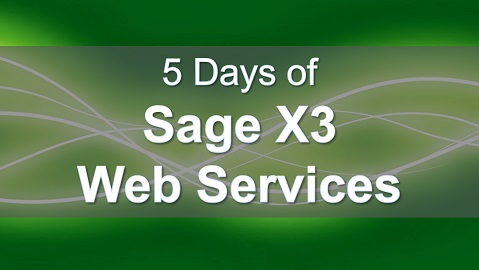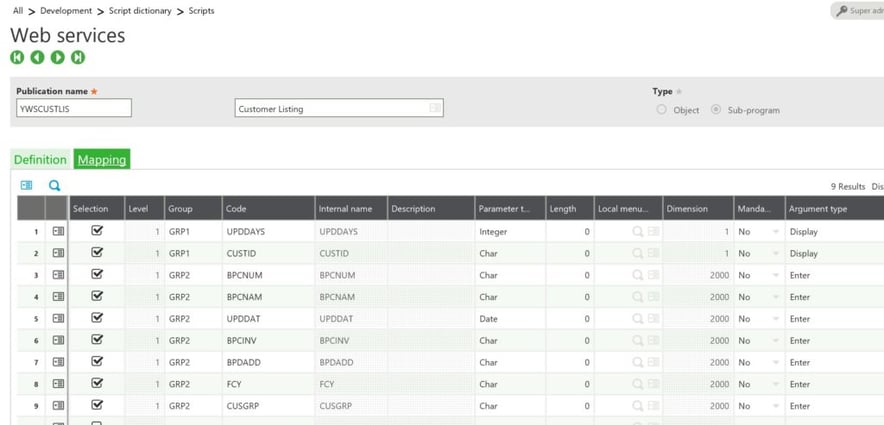Calling a Sage X3 Subprogram From asp.net
This is the final part of a 5 part series on creating and consuming Sage X3 Web Services. This post will focus on calling an X3 subprogram that has been exposed as a web service.
To browse other posts in the series, click any of the links below:
Day 1 – Setting up X3 Web Services
Day 2 – Creating X3 Web Services
Day 3 – Testing X3 Web Services
Day 4 – Calling a Sage X3 Object from ASP.Net
Now on to our current topic Calling a Sage X3 Subprogram from asp.net ...
The wsdl for the X3 web services is below, where x3v6prmp23.rkldev.local is the server name where the web services are hosted.
http://x3v6prmp23.rkldev.local:28880/adxwsvc/services/CAdxWebServiceXmlCC?wsdl
Calling Subprogram Sage X3 Web Services
Create the Call Context
Refer to the post, Day 4 – Calling a Sage ERP X3 Object from ASP.Net, for instructions on creating the Call Context.
Call the Web Service
The example below is based on calling a Sage ERP X3 Web Service that was generated from a custom sub-program. Refer to the post Day 2 – Creating X3 Web Services for instructions on creating a custom sub-program and exposing it as a web service. The code sample below displays the .net code used to call the web service.
-
-
The first step will be to construct the XML parameter list to make the web service call. This will vary based on the parameters defined in the custom web service. The example below is based on web service ZWSCUSTLIS. As shown below, the parameters passed into the web service are UPDDAYS and CUSTID. The results will include an array of up to 2000 customers.
- The XML Parameter string will be constructed as shown below, to match the required parameters for the subprogram call.
-
<PARAM>
<FLD NAME="UPDDAYS" >30</FLD>
<FLD NAME="CUSTID" > </FLD>
</PARAM>
- Call the Web Service
Below is a snippet of the .net code required to call the web service. The web service will return an xml string containing the call results. This string can be parsed to extract the details of the call.
public
List<X3_Account_List> GetAccounts(int iUpdateDays, string sAcctId)
{
List<X3_Account_List> lsAccts = new
List<X3_Account_List>();
// Initialize Connection Values
X3DataAccessConn.CallContextClass oCallContext = _connDetails.GetCallContext();
// Complete call context
oCallContext.CallContext.requestConfig = "adxwss.trace.on=off&adxwss.trace.size=16384&adonix.trace.on=off&adonix.trace.level=3&adonix.trace.size=8";
// Build Input XML with Parameters
StringBuilder xmlInput = new
StringBuilder("");
xmlInput.Append("<PARAM>");
xmlInput.AppendFormat("<FLD NAME="{0}">{1}</FLD>", "UPDDAYS", iUpdateDays.ToString());
xmlInput.AppendFormat("<FLD NAME="{0}">{1}</FLD>", "CUSTID", sAcctId);
xmlInput.Append("</PARAM>");
// Call web service
oCallContext.ResultXML = oCallContext.WebService.run(oCallContext.CallContext, "ZWSCUSTLIS", xmlInput.ToString());
string result = "";
foreach (X3WebService.CAdxMessage msg in oCallContext.ResultXML.messages)
{
result += msg.message.ToString() + "^";
}
// Success
if (result.Length == 0)
{
string xml = oCallContext.ResultXML.resultXml.ToString();
lsAccts = ExtractAccts(xml);
}
return lsAccts;
}
public
CallContextClass GetCallContext()
{
// Initialize connection values
CAdxCallContext callContext = new
CAdxCallContext();
CAdxWebServiceXmlCCService webService = new
CAdxWebServiceXmlCCService();
CAdxParamKeyValue[] paramKey = new
CAdxParamKeyValue[1];
CAdxResultXml resultXML = new
CAdxResultXml();
callContext.codeLang = _x3Language; // Connection language
callContext.codeUser = _x3User; // X3 user
callContext.password = _x3Pwd; // X3 password
callContext.poolAlias = _x3WSPool; // Connection pool name
CallContextClass context = new
CallContextClass(callContext, webService, paramKey, resultXML);
return context;
}
This is the fifth and final post on creating and consuming web services for Sage ERP X3.
Got Questions?
Contact us if you want to learn more about Sage ERP X3 Web Services features.

The Ultimate Web Services Guide For Sage X3
Want all 5 days in one comprehensive guide that you can download and take with you?
Leave your name below and we'll send you a copy of our Ultimate Guide to Sage X3 Web Services. This 38-page how-to manual provides everything you need to know about using X3 web services with screenshots, step-by-step instructions, and insider tips from our expert consultants.





